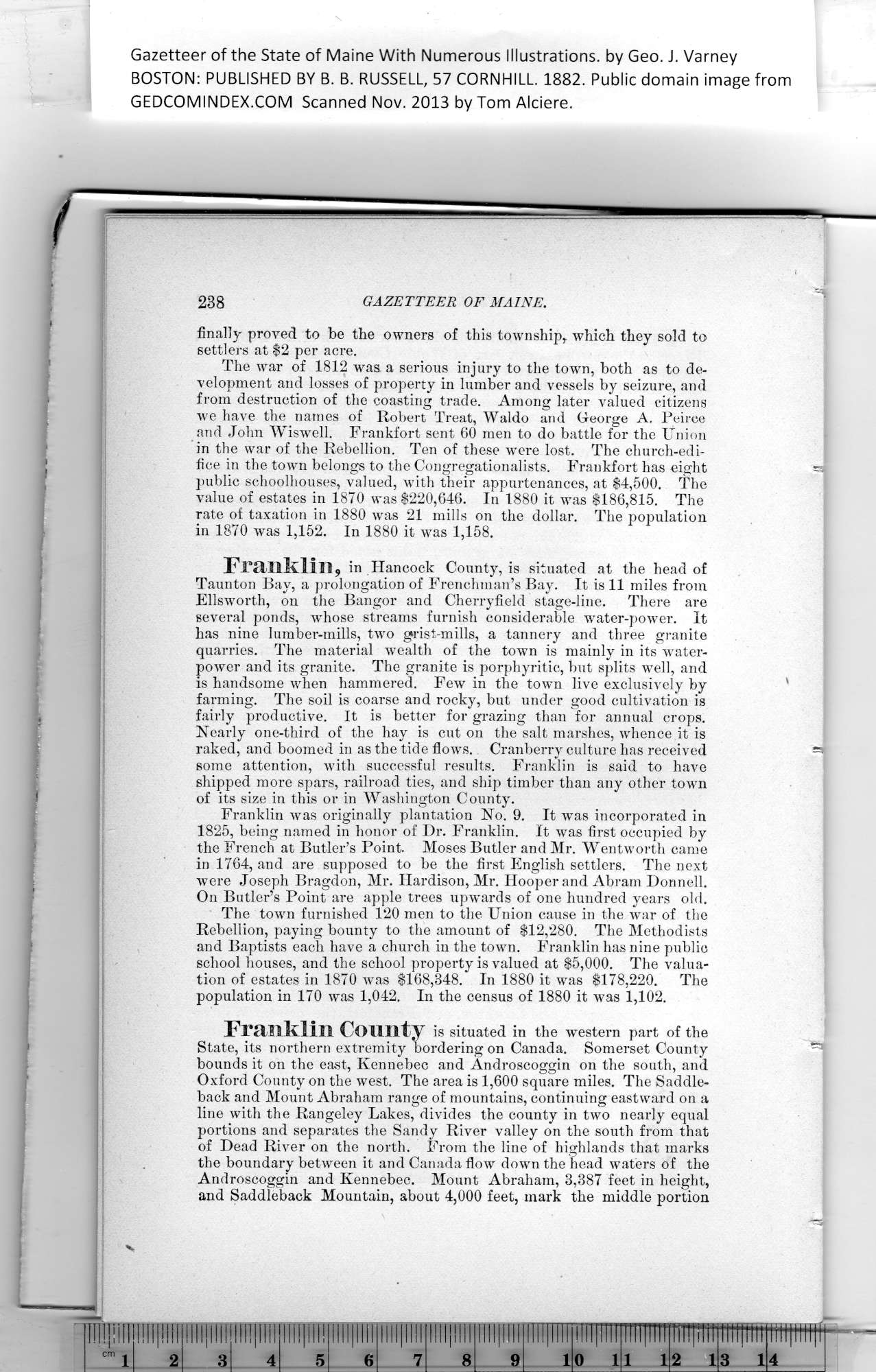|
Gazetteer of the State of Maine With Numerous Illustrations, by Geo. J. Varney
BOSTON: PUBLISHED BY B. B. RUSSELL, 57 CORNHILL. 1882. Public domain image from
238 GAZETTEER OF MAINE.
finally proved to be the owners of this township, which they sold to
settlers at $2 per acre.
The war of 1812 was a serious injury to the town, both as to de-
velopment and losses of property in lumber and vessels by seizure, and
from destruction of the coasting trade. Among later valued citizens
we have the names of Robert Treat, Waldo and George A. Peirce
and John Wiswell. Frankfort sent 60 men to do battle for the Union
in tbe war of the Rebellion. Ten of these were lost. The church-edi-
fice in the town belongs to the Congregationalists. Frankfort has eight
public schoolhouses, valued, with their appurtenances, at $4,500. The
value of estates in 1870 was $220,646. In 1880 it was $186,815. The
rate of taxation in 1880 was 21 mills on the dollar. The population
in 1870 was 1,152. In 1880 it was 1,158.
Franklin, in Hancock County, is situated at the head of
Taunton Bay, a prolongation of Frenchman’s Bay. It is 11 miles from
Ellsworth, on the Bangor and Cherryfield stage-line. There are
several ponds, wTtose streams furnish considerable water-power. It
has nine lumber-mills, two grist-mills, a tannery and three granite
quarries. The material wealth of the town is mainly in its water-
power and its granite. The granite is porphyritic, but splits well, and
is handsome when hammered. Few in the town live exclusively by
farming. The soil is coarse aud rocky, but under good cultivation is
fairly productive. It is better for grazing than for annual crops.
Nearly one-third of the hay is cut on the salt marshes, whence it is
raked, and boomed in as the tide flows.. Cranberry culture has received
some attention, with successful results. Franklin is said to have
shipped more spars, railroad ties, and ship timber than any other town
of its size in this or in Washington County.
Franklin was originally plantation No. 9. It was incorporated in
1825, being named in honor of Dr. Franklin. It was first occupied by
the French at Butler’s Point. Moses Butler and Mr. Wentworth came
in 1764, and are supposed to be the first English settlers. The next
were Joseph Bragdon, Mr. Hardison, Mr. Hooper and Abram Donnell.
On Butler’s Point are apple trees upwards of one hundred years old.
The town furnished 120 men to the Union cause in the war of the
Rebellion, paying bounty to tbe amount of $12,280. The Methodists
and Baptists each have a church in the town. Franklin has nine public
school houses, and the school property is valued at $5,000. The valua-
tion of estates in 1870 was $168,348. In 1880 it was $178,220. The
population in 170 was 1,042. In the census of 1880 it was 1,102.
Franklin County is situated in the western part of tbe
State, its northern extremity bordering on Canada. Somerset County
bounds it on the east, Kennebec and Androscoggin on the south, and
Oxford County on the west. The area is 1,600 square miles. The Saddle-
back and Mount Abraham range of mountains, continuing eastward on a
line with the Rangeley Lakes, divides the county in two nearly equal
portions and separates the Sandy River valley on the south from that
of Dead River on the north. From the line of highlands that marks
the boundary between it and Canada flow down the head waters of the
Androscoggin and Kennebec. Mount Abraham, 3,387 feet in height,
and Saddleback Mountain, about 4,000 feet, mark the middle portion
PREVIOUS PAGE ... NEXT PAGE
This page was written in HTML using a program written in Python 3.2
|
